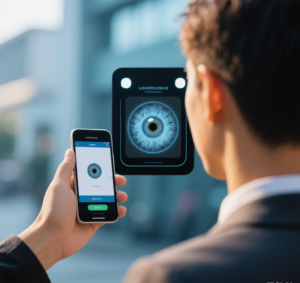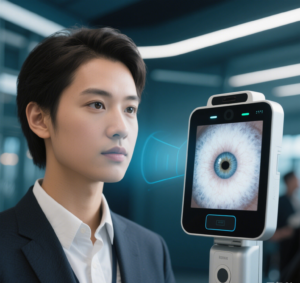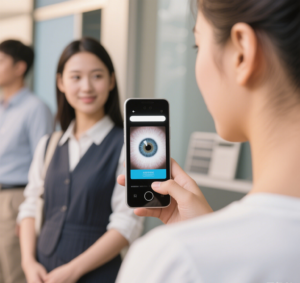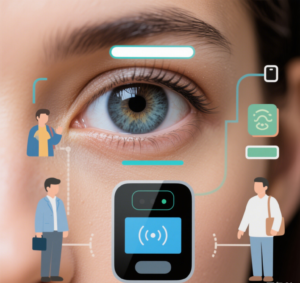Introduction to Iris Recognition
How Iris Recognition Works
1.Image Acquisition
Iris recognition technology uses a specialized camera to capture a high-quality image of the iris, often utilizing near-infrared light to enhance visibility. This advanced biometric method ensures high accuracy, security, and contactless identification, making it ideal for access control, identity verification, and secure authentication in various industries.
2.Iris Localization
Iris recognition technology detects the iris boundaries, separating it from the pupil and sclera (the white part of the eye). This precise segmentation ensures highly accurate and secure identification, making it a reliable biometric solution for access control, identity verification, and secure authentication in government, finance, and healthcare sectors.
3.Pattern Extraction
Algorithms analyze the iris’s unique features, such as crypts, furrows, and freckles, converting them into a digital template.
4.Matching & Verification
Iris recognition technology generates a unique template of the iris and compares it against stored databases to confirm identity. This highly secure and accurate biometric method is widely used for access control, border security, and identity verification, ensuring fast, contactless, and fraud-resistant authentication in various industries.
Thanks to its high level of detail, iris recognition has an extremely low false acceptance rate, making it more reliable than other biometric methods.
Applications of Iris Recognition




1. Security & Law Enforcement
Governments and law enforcement agencies use iris recognition for border control, criminal identification, and national security. Airports, such as those in the UAE and the UK, employ iris scanners for fast and secure passenger verification.
2. Access Control & Authentication
Many high-security facilities, including banks, data centers, and government buildings, use iris recognition to restrict unauthorized access. It is also integrated into smartphones and laptops for secure login.
3. Healthcare & Patient Identification
Hospitals use iris recognition to accurately identify patients, reducing medical errors and ensuring secure access to electronic health records.
4. Financial Services & Transactions
Banks and fintech companies implement iris recognition for secure authentication in mobile banking and ATM transactions, preventing fraud.
5. Time & Attendance Tracking
Corporations and educational institutions use iris recognition technology to efficiently monitor employee and student attendance. This contactless and highly secure biometric method ensures accurate time tracking, prevents identity fraud, and enhances security, making it ideal for workplaces, universities, and high-security environments that require reliable authentication.
Advantages of Iris Recognition
Haute précision
Iris recognition technology leverages the fact that the probability of two irises being identical is nearly zero. This highly secure and precise biometric method ensures accurate identity verification, making it ideal for access control, border security, and financial transactions where fraud prevention and reliability are crucial.
Contactless & Hygienic
Unlike fingerprint scanners, iris recognition doesn’t require physical contact, making it a hygienic and highly secure biometric solution. This advanced technology ensures fast and accurate authentication, making it ideal for access control, border security, healthcare, and financial services where contactless verification is essential.
Fast & Scalable
Modern iris recognition systems can process matches in seconds, even within large databases. This high-speed and highly accurate biometric technology enhances access control, border security, and identity verification, ensuring efficient, contactless, and fraud-resistant authentication for government, corporate, and financial applications.
Fraud-Resistant
The iris is difficult to replicate, making iris recognition a highly secure biometric technology that significantly reduces identity theft risks. This advanced authentication method ensures accurate, contactless, and fraud-resistant verification, making it ideal for access control, banking, border security, and high-security environments.
Challenges & Limitations
High Cost
Specialized cameras and software for iris recognition can be expensive, but they offer unmatched security, accuracy, and contactless authentication. Despite the initial cost, this highly advanced biometric technology is widely used in government, healthcare, banking, and security sectors, ensuring fraud prevention, efficient identity verification, and long-term reliability.
User Cooperation Required
Subjects must position their eyes correctly for iris recognition scanning to ensure accurate authentication. While this may require slight user adjustment, the technology provides high security, contactless identification, and rapid processing. It is widely used in access control, border security, and financial transactions, ensuring reliable and fraud-resistant verification.
Privacy Concerns
Some individuals worry about biometric data misuse, especially with iris recognition technology. However, advanced encryption and secure storage methods help protect sensitive information. This highly secure and contactless authentication method is widely used in government, finance, and healthcare, ensuring fraud prevention, privacy protection, and reliable identity verification.
Future of Iris Recognition
The iris recognition market is expected to grow significantly, driven by advancements in AI and machine learning. Future developments may include:
Mobile Integration
Wider adoption of iris recognition in smartphones and wearables is enhancing security and convenience for users. This advanced biometric technology enables fast, contactless authentication for device unlocking, secure payments, and identity verification, making it a reliable solution for personal security, banking, and access control applications.
AI-Powered Enhancements
Faster and more adaptive recognition algorithms.
Multi-Modal Biometrics
Combining iris recognition with facial or fingerprint scanning for higher security.
FAQ
Yes, iris recognition is non-invasive and uses harmless near-infrared light for scanning.
Most modern iris scanners can work with glasses and soft contact lenses, though reflective coatings may interfere.
Iris recognition is more accurate, with a false match rate of about 1 in 1.5 million, compared to 1 in 500 for fingerprints.
It is extremely difficult due to the iris’s complex and unique patterns.
Airports, high-security facilities, smartphones, and banking systems frequently use iris recognition.
Conclusion
Iris recognition is a cutting-edge biometric technology with unmatched accuracy and security. Its applications span security, healthcare, finance, and beyond. As technology evolves, iris recognition will likely become more accessible and integrated into everyday life, reinforcing its role as a leading authentication method.

